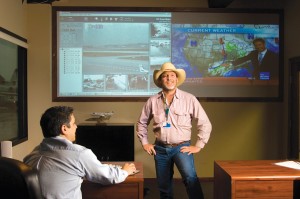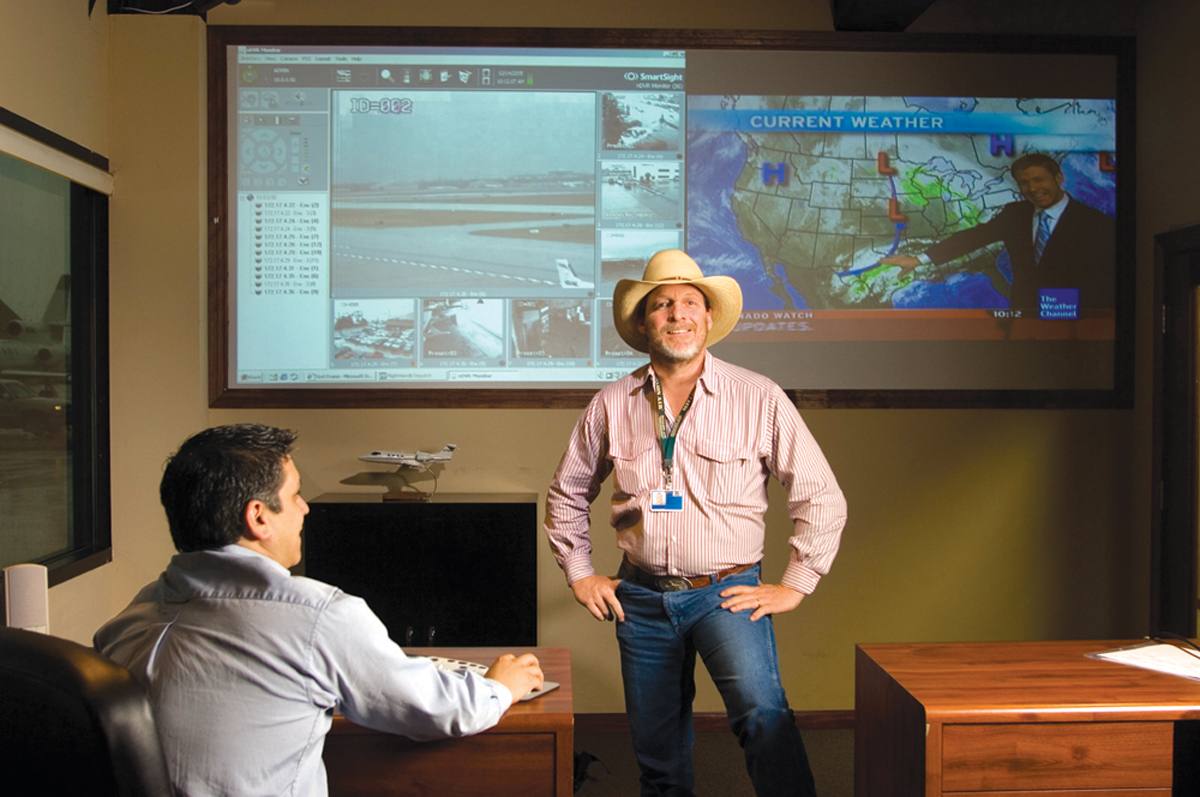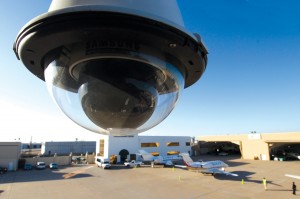Million Air Houston (HOU) recently completed a two-year joint effort with Navigance Technologies Group to help create and test a fully integrated website-based wireless security system that provides a transparent security umbrella over its 52-acre complex.
The prototype security platform designed by Navigance now ensures that Million Air at Houston Hobby Airport meets FAA and TSA gateway requirements for all business aircraft en route to Ronald Reagan Airport (DCA), which reopened to general aviation traffic late last year. Houston is one of only eight approved gateway cities for DCA.
“With the Navigance SAFE System, our facility has the security to ensure safe, unfettered travel to and from DCA–or any other airport for that matter–and protects our customers’ high-end assets,” said Bruce Lambert, Million Air director of information technology. “Now we can recommend the Navigance system to other Million Air facilities that look to us for technical guidance.”
The Navigance SAFE System provides restricted-access to the facility and manages risk on ramps and in hangar areas, using a secure high speed wireless network design.
The 200-employee Million Air FBO at Houston Hobby serves some 25 base customers out of 15 hangars, including leased aircraft storage space and a complete maintenance operation. With American Jet International operating a fleet of 14 charter aircraft out of the facility, plus a large volume of transient flights a day, Million Air is one of the busiest FBOs in the country.
An idea becomes reality
Lambert said that creating this security system has been a work in progress.

This customer service representative uses biometric access control to take catering to awaiting aircraft.
“Navigance was the first third-party tech support vendor we ever let in. At first, I wasn’t sure this was the way to go, but now I know I can count on them,” Lambert said.
In mid-2003, Bob Jandebeur, Navigance president, offered Million Air a chance to help conceptualize and create a fully integrated security system for their facility. Jandebeur brought experience from previous security network setups at locations such as the Million Air facility at Salt Lake International for the 2002 Winter Olympics and systems at other aviation facilities.
But Million Air headquarters would be different. Aerial photographs would be used and a complete diagrammatic layout of Million Air’s ramp and hangar space would be analyzed to determine camera locations and positioning of access controls.
“I credit Bruce’s patience during the process, where each of us shared the same vision that we were ahead of the marketplace of offering security to our customers. Handholding was a key element that led to the success,” Jandebeur said. “We even mapped out a program for Million Air to use the wireless technology with their fuel trucks to deliver high speed Internet on the ramp–a technology first.”
This concept proved very useful during Super Bowl XXXVIII for the many pilots and passengers arriving and leaving Houston.
“Total cost for the Navigance system was less than we expected and well worth it,” Lambert said. “Of course, what we paid wasn’t a true representation, considering Navigance never charged us for the extra hours spent on perfecting the system. Those are the costs you never recover when building a prototype. I would imagine an FBO could have Navigance install a system similar to ours for about $95,000.”
Creating prototype not easy

CEO Roger Woolsey (left), CFO Terry Cross and Sandy Nelson, VP of marketing, use the FBO’s security system to view real-time activity on a laptop computer.
Million Air worked closely with Navigance to come up with the original security system architecture. It was a trial-and-error process. Initially, all the software was downloaded onto one server. This step hindered the simultaneous operation of cameras and access controls, which meant the system wasn’t performing at peak potential.
The obvious question to Million Air: Why couldn’t the access controls and cameras work together to perform their assigned functions? The answer was simple. Both security tools couldn’t work from the same server. Million Air’s discovery became the blueprint for future Navigance integrated systems.
Lambert recommended that Navigance install separate servers for each component of the security system, rather than relying on a single computer to handle biometric readers, door and gate access control and the video camera controls and recording.
“We had to reset our recording system every few weeks or the recordings could have a bunch of frozen pixels, making it hard to see activity in certain areas of the screen,” he said.
Lambert was certain it would take only a simple reinstall of the recording program to eliminate the problem.
“Although our server is wicked fast, it still can be undone by bad software,” he said. “Combine a bad DVR program install with brittle biometric software on a single server, and you’re asking for one or the other program to pull the entire system down. We discussed with Navigance that the solution was to have dedicated servers for each computer application–-DVR, biometrics, access controls, accounting, fuel sales, whatever. Multiple servers would work best.”
Jandebeur adds, “Today, from the cooperative effort by two general aviation pioneers in developing this security system, Navigance has established a solid technology base, using a DVR unit that interfaces with a new innovative access control process. It’s important that this system doesn’t require a server.”
He said the SAFE system server now acts as a portal to each customer’s system.
“That allows us to offer the unique ability to be a ‘virtual IT’ department,” he said. “The majority of companies can’t justify having an IT department like the Million Air chain, so we fill that roll via the website.”
Cameras, access controls are key
The Navigance-designed security system at Million Air includes eight cameras and biometric and magnetic card access controls on gates and doors.
The Million Air security system has met challenges from the start. When airport construction closed the FBO’s main gate in late 2005 and forced customers and employees to use alternate access, the security system proved to be flexible and useful.
“We’ve used the cameras to monitor construction and our facilities, and used the access controls to change how people get in and out of here,” said Lambert. Access control programming flexibility made those changes easier.
Ray Murphy, Million Air operations director, said the security system is foreword thinking.
“Our goal is to keep people ‘in’ our building instead of keeping them out,” he said. “We want un-badged visitors where we can see them and know what they’re doing, rather than have them running around among the airplanes without an escort.”
The cameras record activity around the clock on the ramp and aircraft pull-in and parking areas, in tenant and maintenance hangars and at access gates and parking lots. With Million Air’s focus on customer safety and service, and on its own bottom line, the FBO immediately understood what the Navigance program could do. By controlling airport and hangar access, and by keeping digital video recordings of activity at key areas, Million Air could offer tenants and transient customers’ complete peace-of-mind–and the possibility of reduced insurance costs.
“When you have a recording of everything that happens in a hangar, it’s easy to determine who is–and isn’t–at fault in an incident,” Lambert said.
With the security system up and running, Million Air’s goal is to use it to give customers the secure feeling that they’re housing their aircraft in a fully monitored facility.
The human solution
Security is a safety net, Murphy said. “Technology can only enhance a human’s ability to do a job,” Murphy said. “Our security system can’t possibly replace the human ability to instantly recognize when somebody doesn’t belong, or something is out of place.”

Million Air IT Director Bruce Lambert visits the dispatch area where the FBO’s security is monitored.
Murphy added that while there is value in having his staff monitor the cameras 24/7 on a giant screen in the charter dispatch area, it wouldn’t make them responsible for security, since it can be so busy at a moment’s notice.
“This points out one of the real benefits of the SAFE system, since the security tools can be programmed to automatically notify you of motion alerts, plus interface with the access control system to view events or alarms real time via a laptop or PDA,” said Jandebeur.
Since Million Air is a tenant of HOU, it must also participate in the Houston Hobby security system, which restricts FBO access by gate number. The airport authority requires tenants to undergo background checks, be accepted by FAA security and wear HOU security badges with specially coded access for their approved gates.
“The airport security system makes us deal with multilayered security, adding to the bureaucracy and paperwork,” said Murphy. “We’re looking to Navigance for some kind of interface, to allow our security system to talk with the airport’s system and be compliant and accept our badging and access control. It would be better if each airport had one security system and shared data and access limits with all tenants.”
What the future holds
Lambert plans to continue augmenting the FBO’s current system with newly enhanced color cameras and the latest digital video recorders.
“Million Air can help establish an example for others to follow-—a common sense approach for security with safety enhancements,” Lambert said.













